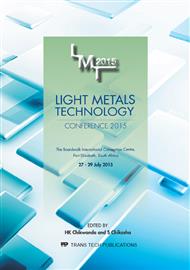[1]
S. K. Chaudhury and D. Apelian, Effects of rapid heating on solutionizing characteristics of Al-Si-Mg alloys using a fluidized bed, Metallurgical and Materials Transactions A, 37A (2006) 763-778.
DOI: 10.1007/s11661-006-0048-4
Google Scholar
[2]
G. Ran, J. E. Zhou and Q. G. Wang, Precipitates and tensile fracture mechanism in a sand cast A356 aluminum alloy, Journal of Materials Processing Technology 207 (2008) 46-52.
DOI: 10.1016/j.jmatprotec.2007.12.050
Google Scholar
[3]
S. K. Shaha, F. Czerwinski, W. Kasprzak and D. L. Chen, Work hardening and texture during compression deformation of the Al-Si-Cu-Mg alloy modified with V, Zr and Ti, J. Alloys Compd. 593 (2014) 290-299.
DOI: 10.1016/j.jallcom.2013.12.081
Google Scholar
[4]
H. A. Elhadari, H. A. Patel, D. L. Chen and W. Kasprzak, Tensile and fatigue properties of a cast aluminum alloy with Ti, Zr and V additions, Mater. Sci. Eng. A 528 (2011) 8128-8138.
DOI: 10.1016/j.msea.2011.07.018
Google Scholar
[5]
S. K. Shaha, F. Czerwinski, W. Kasprzak and D. L. Chen, Tensile and compressive deformation behavior of the Al–Si–Cu–Mg cast alloy with additions of Zr, V and Ti, Materials and Design 59 (2014) 352-358.
DOI: 10.1016/j.matdes.2014.02.060
Google Scholar
[6]
S. K. Shaha, F. Czerwinski, W. Kasprzak, J. Friedman and D. L. Chen, Effect of Zr, V and Ti on hot compression behavior of the Al–Si cast alloy for powertrain applications, Journal of Alloys and Compounds 615 (2014) 1019–1031.
DOI: 10.1016/j.jallcom.2014.06.210
Google Scholar
[7]
S. K. Shaha, F. Czerwinski, D. L. Chen and W. Kasprzak, Dislocation slip distance during compression of Al–Si–Cu–Mg alloy with additions of Ti–Zr–V, Materials Science and Technology 31(1) (2015) 63-72.
DOI: 10.1179/1743284714y.0000000606
Google Scholar
[8]
W. Kasprzak, B. S. Amirkhiz and M. Niewczas, Structure and properties of cast Al-Si based alloy with Zr-V-Ti additions and its evaluation of high temperature performance, J. Alloys Compd. 595 (2014) 67-79.
DOI: 10.1016/j.jallcom.2013.11.209
Google Scholar
[9]
S. K. Shaha, F. Czerwinski, W. Kasprzak, J. Friedman and D. L. Chen, Monotonic and cyclic deformation behavior of the Al-Si-Cu-Mg cast alloy with micro-additions of Ti, V and Zr, International Journal of Fatigue 70 (2015) 383-394.
DOI: 10.1016/j.ijfatigue.2014.08.001
Google Scholar
[10]
S. K. Shaha, F. Czerwinski, W. Kasprzak, J. Friedman and D. L. Chen, Thermal stability of (AlSi)x(ZrVTi) intermetallic phases in the Al–Si–Cu–Mg cast alloy with additions of Ti, V, and Zr, Thermochimica Acta 595 (2014) 11-16.
DOI: 10.1016/j.tca.2014.08.037
Google Scholar


